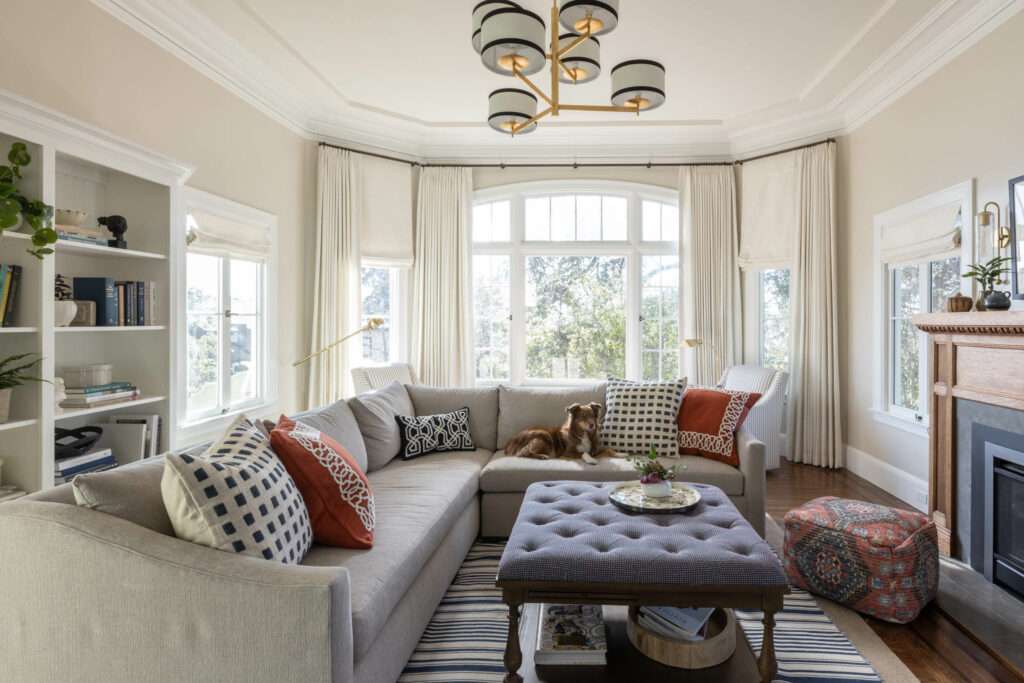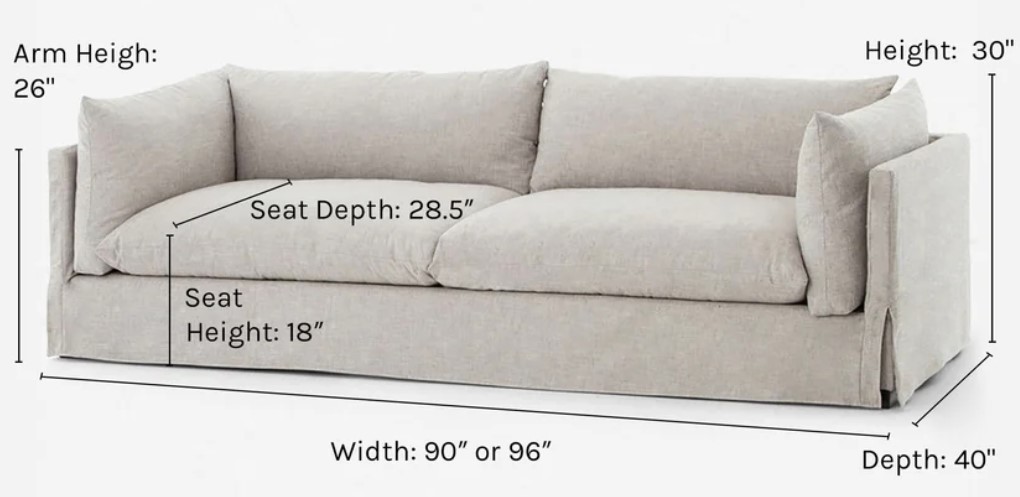Book a Complimentary Discovery Call
Speak with our Principal Interior Designer, Dana Feagles.
Tell us about your project, your needs, your hurdles, and your aspirations.
Learn how we can help.

A comfortable, quality sofa is truly the sum of its parts. It’s not just the cushions – you have to consider the frame construction and the suspension system as well.
As I’ve said before, it’s not always feasible to prioritize quality over price. But I draw the line at sofa quality.
Please learn from my mistakes.
As an interior design student, I thought I knew everything (eye roll). Since I had recently moved in with my partner-now-husband, I declared that his IKEA sofa HAD TO GO. And I knew where I wanted to get us a replacement – the “custom sofa” shop down the hill from us on Union St.
What could be better than what seemed like a reputable business on the posh Union St.? They had nice fabric and customization options.
Guess what? That sofa, while “affordable,” lasted us maayybbee 3 years. I vividly remember when we threw it into the Marin County dump, one move and 2 babies later. I felt a tinge of sadness (I get attached to my furniture) as well as environmental guilt. It couldn’t be reupholstered. The actual frame was falling apart. The seat deck was sagging almost to the floor. So what if our elderly dog had peed on the cushions – those could easily be replaced. But it was not salvageable.
The impetus for Sofa #1 getting dumped was this – I stumbled across an amazing looking sectional for only $999 at Costco. (My Costco sectional is no secret). When I saw it, I thought it would be PERFECT for our new family of 4. It was large and modular. The pieces could be rearranged into different configurations to suit our current needs. It was only $999. In case you didn’t know, that is a terrific price for a large sectional. My reasoning was that with two young children, anything we bought was going to get utterly destroyed.
I was definitely in the “we can’t have nice things” mindset.
But guess what? It was utterly destroyed. The psychology of it is interesting. I remember walking into the room and seeing my then-2-year-old coloring on the modular ottoman piece with a marker and thinking “Eh, it’s from Costco, who cares.” 3 years later, that mentality has left us at a disadvantage. The staining and overuse has been rationalized away because “it was a cheap Costco sectional.” Despite having it annually cleaned by a professional (which I always recommend to all of my clients), I Just. Don’t. Like it.
Had we purchased an actual quality sectional that I LOVED, would I have been quicker to clean up that marker? You bet I would have.
You probably lounge on yours every single day. You also probably drive in your car every single day. Are you comfortable in your car? Do you feel proud in your car? Are you happy knowing you made a good car purchasing decision?
A sofa shouldn’t be any different. Investing in your sofa quality is like buying a luxury vehicle. It will offer spectacular performance with little maintenance, you can sit in it and feel proud, invite others to sit in it and feel proud, and you can keep it for years and years and eventually give it to your children when they’re old enough.
(Think I’m kidding? I can’t even count on both hands how many projects I’ve completed that involved empty-nesters giving their old furniture to their children who had recently moved into their own apartments and needed the free furniture!).
Here are the 5 key factors that make a quality sofa. Learn from my mistakes, read the fine print, and invest a little bit more in your long-term happiness.
WTF is a sofa suspension system? I thought we were done talking about cars?
The sofa suspension system supports the cushions and the weight of the people sitting on the sofa. The highest-quality materials are hand-tied springs or high-density foam. 8-way hand-tied springs are considered the highest quality suspension system. Coil and Sinuous springs are also used but are more likely to break. Hand-tied springs are individually tied to the sofa frame by hand, which creates a consistent level of support throughout the sofa. This method of construction also allows for the springs to be replaced individually, which can extend the lifespan of the sofa (hello and good-bye, Marin County dump).
Coil springs, on the other hand, are less expensive to manufacture and therefore used in lower quality sofas. Coil springs are pre-made and are attached to the sofa frame with clips or staples. This method of construction can result in uneven support and can cause the sofa to sag over time. (i.e. My Union St. custom sofa probably had coil springs).
The second factor to consider when choosing a quality sofa is the type of material used for cushioning, and how the cushion is constructed.
Seat cushions should be constructed of high-density foam and wrapped in either down (more expensive) or poly-dacron (more affordable and better for people with allergies).
Cheap foam is constructed with more air and less material, making it more prone to flattening over time. High-density foam has less air and more material, making it the better choice for prolonged comfort. The wrap is what gives the cushion that more luxurious, pillowy feel, while the high-density foam underneath prevents the cushion from losing its shape.
The most expensive, cloud-like seat cushions will be all down and no foam, but these cushions require constant fluffing, as they easily lose their shape. That is why I always specify my sofas to have down-wrapped high-density foam seat cushions. You get the comfort of down without the cushion maintenance.
While foam is the most commonly used material, the most luxurious are down and horsehair. Polyester is at the bottom of the list. I’ll break it down for you in order of quality and price.
Back cushions should be filled with feathers and down, not polyester stuffing (which will ball up and lose its shape) or foam (much too rigid for a back rest).
The industry has specific standards and lingo for feather/down fill options – I usually specify a 75/25 feather/down fill, meaning 75% of the cushion fill is feathers, and 25% is down. The feathers provide the structure and spring-back feel, while the down provides the sinking-in softness. Some people prefer an 85/15 fill for slightly more firmness, or a 90/10 fill for the most firmness, while a 50/50 fill is considered the most luxurious (but again, this fill will require constant fluffing!).
Also, all cushions should be encased in a feather-lock ticking to minimize the feathers poking through!

This is one of the most common complaints I hear from clients who come to me after they’ve made the wrong purchasing decision – their sofa isn’t deep enough.
A comfortable seat depth is at least 28″, with anything over 30″ considered a luxe lounging sofa (and hard to get out of!). Most sofas on the market have a seat depth of around 20-22″. This is perhaps because the smaller the sofa, the less material is needed in its construction, the easier it is to ship, and so the cheaper the cost.
Ultimately, expect to pay more for a deeper sofa. Note that the seat depth is the distance from the front of the seat cushion to the front of the back cushion (not the overall depth of the sofa!).
The sofa frame should be made of quality hardwood or plywood (not particleboard or MDF) and hand-joined and screwed together (rather than stapled together). Most cheap, mass-produced sofas use frames that are held together with staples. This means that over time, and in as little as a year, you’ve got a sofa that is wobbly, falling apart at the joints, and can’t be fixed unless you completely strip the upholstery to get down to the frame, at which point, you may as well invest in a new sofa.
Before you say “oh man, she’s so woo-woo Earth mother now” – the use of environmentally friendly materials and manufacturing processes is becoming increasingly important in the furniture industry. High-quality sofas may use materials that are certified as sustainable, such as FSC-certified wood, or use low VOC materials to reduce the impact on the environment and indoor air quality.
VOCs, or volatile organic compounds, are chemicals that are emitted from certain materials, including furniture. These compounds can have negative effects on indoor air quality and can contribute to a range of health problems, including respiratory issues and headaches. Low VOC furniture is designed to minimize the amount of these harmful compounds that are emitted, providing a range of benefits for both individuals and the environment.
Lastly, rely on your fabric choice for comfort if the above options are out of reach or unknown during your sofa search (indeed, many retailers don’t disclose how their sofas are made). Because fabrics can vary wildly among retailers, I always recommend ordering fabric swatches before making a decision, even if you have to pay for the swatches. It’s a small fee to pay to avoid making a very costly mistake.
Wool is my favorite textile to use for softness, with cotton/linen blends a more affordable and more widely available choice. Brushed or washed linen is usually softer than basketweave linen. Velvets are of course soft but can easily capture lint and pet hair.
Believe it or not, performance fabrics have come a long way and you can find polyester that is soft to the touch. Solution-dyed acrylic fabrics, like those used in outdoor fabrics, tend to feel stiffer but it completely depends on the weave. I’ve used a solution-dyed acrylic velvet from Perennials that is silky soft and I wouldn’t have known had I not seen the swatch first!
Leather is also a popular choice for high-quality sofas due to its durability and classic look. It is easy to clean and maintain, and can develop a beautiful patina over time. However, it can be expensive and may not be the best option for households with pets or young children.
The design and craftsmanship of a sofa can also impact its quality. Expert craftsmanship is essential to ensure that the sofa is built to last and is comfortable to sit on. Details such as hand-stitched seams and carefully crafted curves can make a significant difference in the overall quality and durability of a sofa.
Until next time!
Dana
P.S. For more interior designer tips, resources, and all things Wine Country and Interior Design, check out my blog here!
Speak with our Principal Interior Designer, Dana Feagles.
Tell us about your project, your needs, your hurdles, and your aspirations.
Learn how we can help.